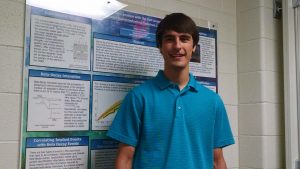 Refining the r-process Described by Theoretical Models
Refining the r-process Described by Theoretical Models
Research Advisor: Dr. Paul DeYoung
Where did all of the heavy elements originate? The rapid neutron capture process (r-process), currently only characterized by theoretical calculations, model the nuclear reactions that lead to heavier nuclei in intense astrophysical locations such as supernovas. Experimenting with the few reactions reproducible on Earth can refine the theoretical calculations of reactions currently impossible to replicate. A cocktail beam of heavy nuclei associated with the r-process around 104Nb with a magnetic rigidity of 3.2097Tm was produced at the National Superconducting Cyclotron Laboratory. The beam implanted in an energy and position detector located inside an efficient gamma detector called the Summing NaI(Tl) detector (SuN). Beta-decay events were correlated to implantation events to identify the A and Z of the decayed nucleus. Using the correlated gamma-ray energies measured in SuN, values such as the beta-decay intensity distribution will then be calculated and compared to values predicted by models that are used to calculate the abundance distribution of the various nuclei observed today.
This material is based upon work supported by the National Science Foundation under grant No. PHY-1306074

